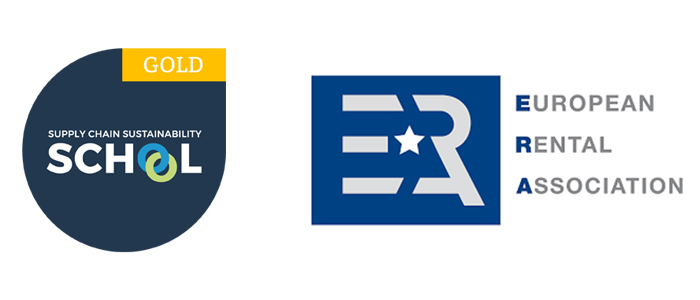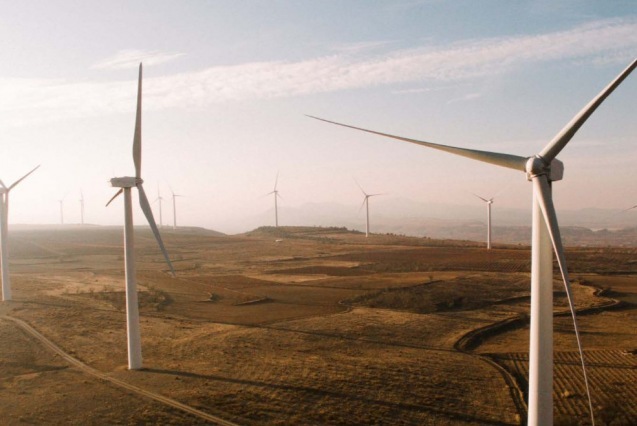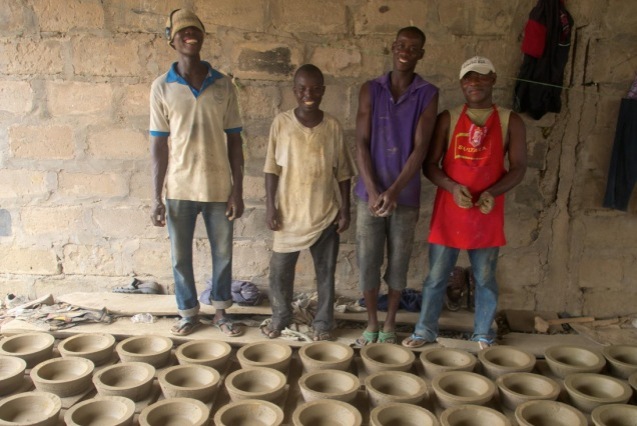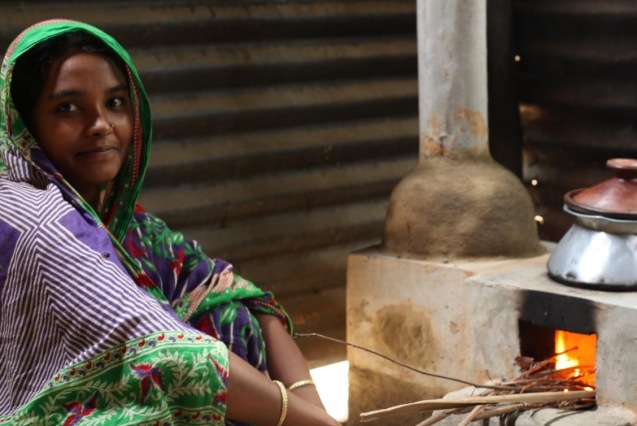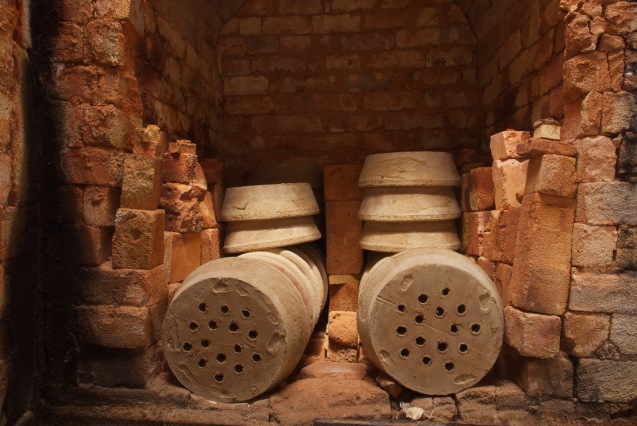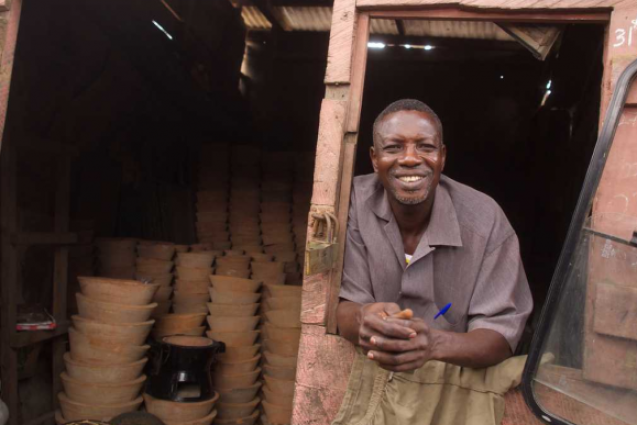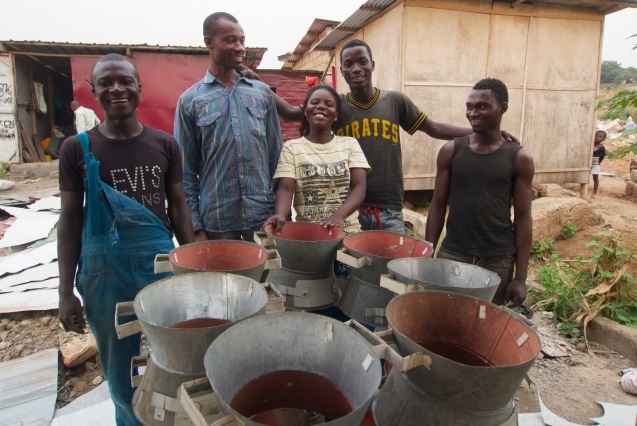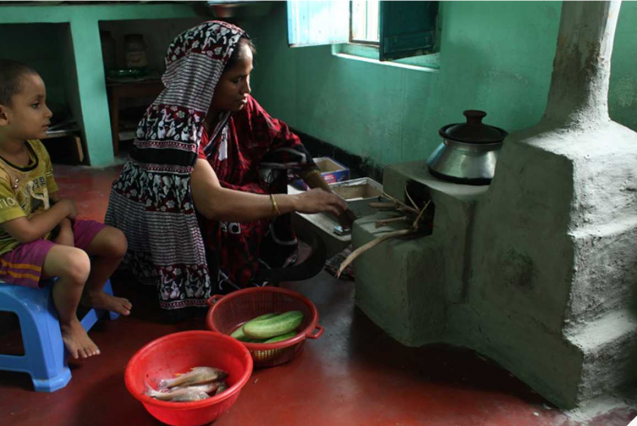Sustainability
Ardent Hire is the UK’s premier hire company. Doing business ethically and in a sustainable way is important to us.
We have a responsibility to conduct our operations in a sustainable manner and so reducing our carbon footprint and energy use is central to that duty.
We are committed to achieving our target of becoming carbon neutral by 2035, whilst engaging to reduce our overall carbon footprint by 10% over the same period. Our commitment to reducing energy consumption and carbon emissions is underpinned by our Sustainability Strategy and will be supported by our carbon offsetting schemes. This policy relates to energy from all Ardent’s activities.
We will comply with all applicable legal requirements which relate to energy and carbon aspects and where practicable apply accepted best practice in energy management.
We commit to:
- Continually improving the energy efficiency of our operations;
- Increasing energy and carbon efficiency through a framework of programmes of energy and carbon saving measures, working with third parties where appropriate to introduce innovation in this area;
- Reviewing our objectives and energy performance and seek continual improvement through applying the principles and recommendations through ESOS.
- Making available adequate resources and information to achieve our energy objectives;
- Communicating this policy to all our staff and share our policy and commitment to energy reduction with our stakeholders;
- Encouraging energy efficiency throughout our workforce and good energy and carbon management in our supply chain;
- Being transparent, measuring and publish information on energy use, greenhouse gas emissions and our performance against our regulated targets annually;
We’re pleased to announce that we’ve teamed up with climate and sustainable development experts ClimateCare to offer a world class carbon offsetting programme for our customers.
At Ardent, being fuel and carbon efficient is our number one environmental priority. We’re continuing our massive fleet renewal programme by investing in the latest construction machinery which are around 30% more fuel efficient than the older models they replace. In addition, we have heavily invested in a new transport fleet that meets the latest European emission standards and we’re now working with several suppliers who share our vision of reducing our carbon footprint in every area of our organisation.
We’re incredibly proud to have won several important sustainability awards and we’re delighted to be recognised for environmental leadership by some of our largest customers.
What is carbon offsetting?
We know many of our customers share our commitment to responsible plant hire and will want to reduce the carbon footprint of their hired-in machinery.
Plant hire is a greenhouse gas emissions offender. Electric machines for smaller categories are starting to be available but in the larger categories they continue to be underpowered and hugely more expensive than diesel machines. In the absence of any regulatory impositions, our view is that technology still needs to evolve and adoption will take time. This is likely to take years.
We need to take action now. Our view is that waiting for technology to catch up is not an option when the environmental crisis is becoming more severe as each week passes.
Carbon offsetting is your opportunity to reduce the carbon footprint of your hired-in machinery without impacting performance. Your CO₂ can be offset by paying a small amount each week that goes towards carbon reduction projects, to reduce emissions equivalent to those generated by your utilisation. You can offset all or part of your CO₂ output.
Carbon offsetting is important because it allows you to make a positive contribution to the environment when your emissions can't be avoided. In addition, investment in carbon offset projects can change lives, bringing economic, social and health improvements to whole communities.
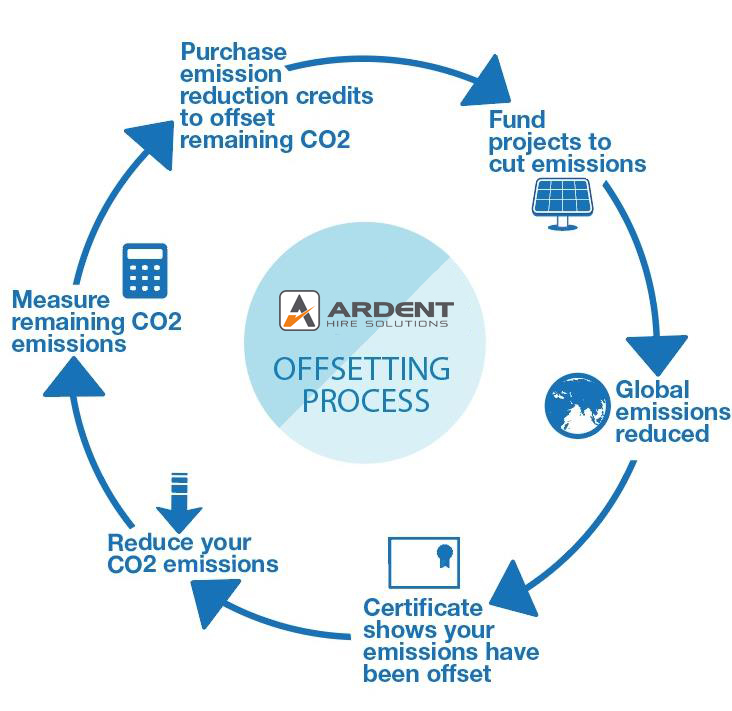
How do you offset your hired-in plant?
We’ve made offsetting really easy.
| Step1 | When placing your order with us, let us know you want to offset your carbon. Your offsetting request will be shown as a separate line item on your order and invoice. If you’re ordering through Ardent InSite you’ll be presented with an option for making your hire carbon neutral |
| Step 2 | Use your hired equipment as usual |
| Step 3 | Receive a monthly certificate showing the amount of carbon you have offset for that period. |
| Step 4 | View all your carbon offsetting certificates in your Ardent InSite portal. |
Where does your money go?
Today’s best carbon offset projects are the ones that not only have a big carbon reduction impact but also benefit communities, and that’s where ClimateCare comes in. They’re a brilliant example of this thinking and have a range of projects that deliver a wide range of benefits.
Read about the projects we're investing in here.
Who are ClimateCare?
In our search for a carbon offsetting partner we wanted to find a company that reflected our values. Our partner needed to offer a gold standard offsetting programme and one that we could confidently recommend to customers. ClimateCare stood out for their deep knowledge of offsetting projects, and for their solid business and finance background. We know we can trust ClimateCare. They’ve done all the thinking, have the latest information to hand and bring verifiable projects that are easy to implement.
And ClimateCare are the highest ranked B-Corp in the UK. B-Corp is a ranking of companies that balance profit with purpose and consider the impact of what they do on their suppliers, employees, customers and the environment. There are only 2,500 companies in the world who are B-Corp accredited. It’s an exclusive club of true innovators and we’re incredibly excited to be working with one of them. The result? So far ClimateCare have cut over 33 million tonnes of CO₂ and improved quality of life for more than 34 million people around the world
What do I pay?
| Billing Band | Machines Included In Band | Fixed Weekly Rate (Charged Per Machine) | |||||||||||
| 1 |
|
£0.50 | |||||||||||
| 2 |
|
£1.00 | |||||||||||
| 3 |
|
£1.50 | |||||||||||
| 4 |
|
£2.00 | |||||||||||
| 5 | 14.0m Telehandler
|
£2.50 | |||||||||||
| 7 |
|
£3.50 | |||||||||||
| 9 | 23.0 Tonne Excavator | £4.50 | |||||||||||
| 10 | 30.0 Tonne Excavator | £5.00 | |||||||||||
| 17 | 36.0 Tonne Excavator | £8.50 | |||||||||||
| N/A |
|
Carbon neutral as of October 2021 |
Best Sustainability & CSR Initiative
Hire Association of Europe (HAE) Awards 2021
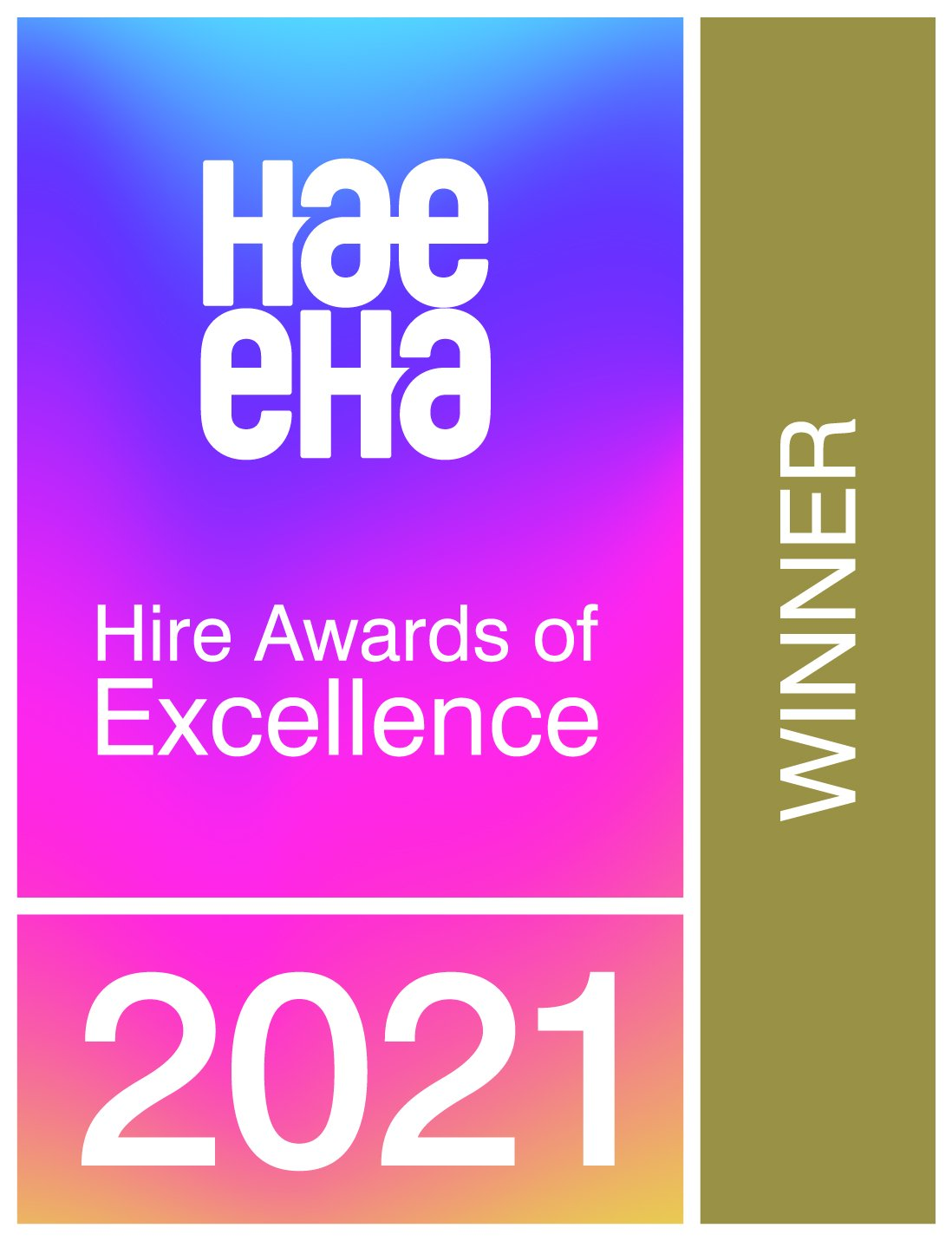
Tacking Climate Change Award (sustainable plant hire)
Construction News Specialist Awards 2021
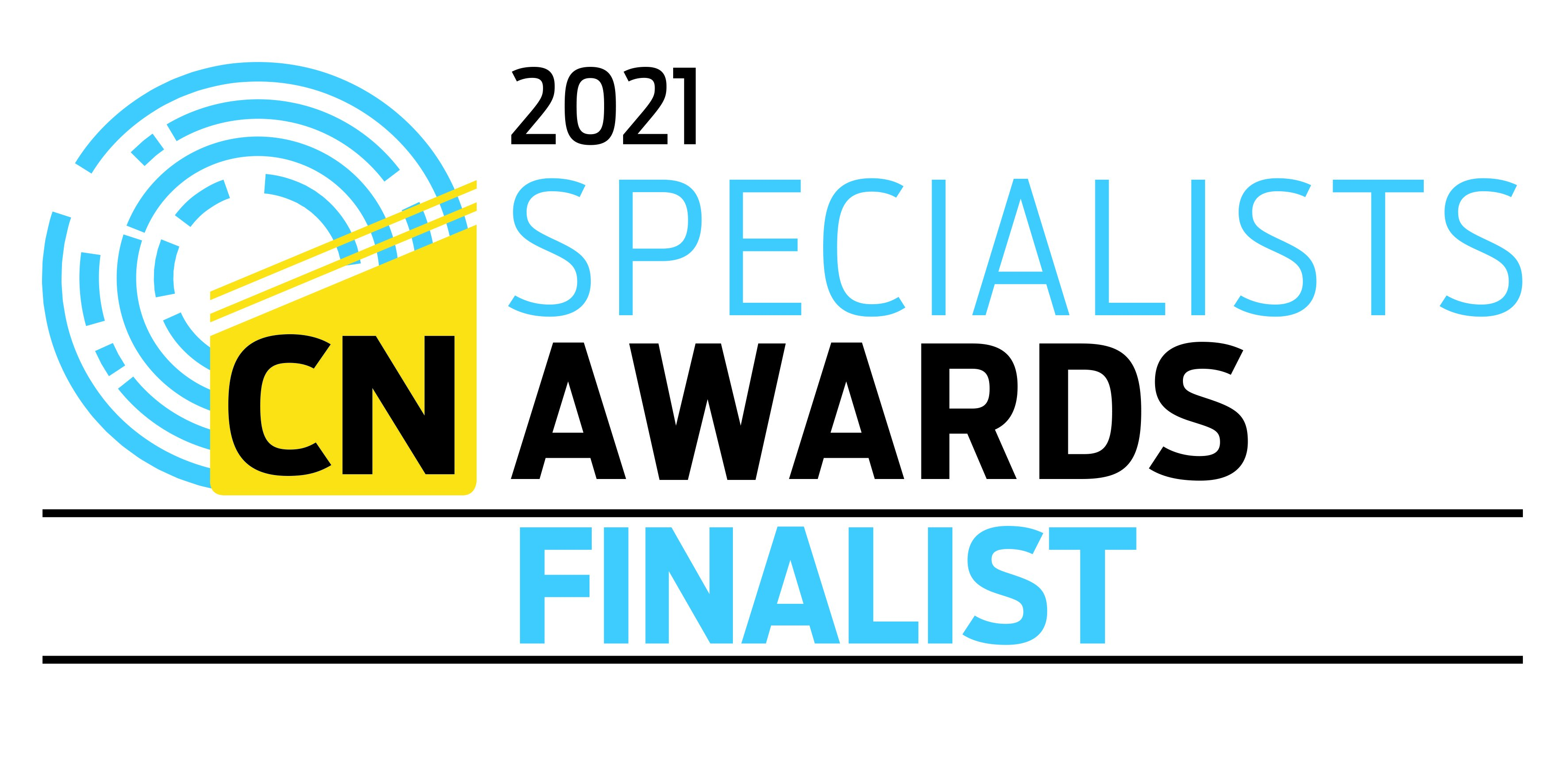
What Is Carbon Offsetting?
Offsetting is the mechanism through which companies can take responsibility for carbon emissions generated by their business activities that are difficult or impossible to avoid. It operates like a seesaw, with your carbon emissions balanced by equivalent emissions reductions delivered by projects in the developing world.
This balance is tracked by carbon certificates, or ‘credits’ with each credit being representative of one tonne of carbon emissions that have been reduced or avoided.
Ardent and ClimateCare are monitoring and calculating the emissions associated with your hired plant's carbon footprint. Once we have your total carbon footprint in tonnes, Ardent purchases an equivalent amount of carbon credits from projects around the globe. This provides a key source of finance for these projects, which are improving lives alongside cutting carbon.
Why Don’t We Just Reduce Emissions?
It is important to reduce carbon emissions as much as practicable first. We’re already exploring ways to ways to reduce carbon emissions, including exploring using electric vehicles for our fleets. If you are a Site Manager user, then you have already taken the first steps to minimise your fuel consumption and reduce your CO2 emissions. You can measure this using Site Manager Analytics.
Despite our best efforts to reduce emissions, there will always be a residual carbon footprint which it is vital to take accountability for; offsetting is the clear and internationally recognised way of doing this.
Carbon offsets have had a huge impact on combatting climate change with over 1 billion tonnes of carbon emissions avoided by thousands of projects since 1997. They are used by leading governments, NGOs and corporates, including the World Bank, WWF, the ICMPD, the OECD and the governments of Kenya, Sweden and Norway.
How Is Offsetting My Co2 Going To Help Reduce The Threat Of Climate Change?
Climate change is one of the most serious threats facing global society. We all need to make every effort to reduce our carbon footprint as much as we can; we should offset the emissions we can’t reduce now.
Offsetting tackles climate change by:
- making real reductions in amounts of CO2 in the atmosphere that otherwise would not have happened;
- providing funds for renewable technologies and energy efficient solutions;
- raising awareness of the impact that our lifestyles have on the climate.
Does this initiative Meet Industry Standards?
Yes. ClimateCare's carefully selected projects follow the same robust process of design, monitoring and independent verification as set down by the UN’s Clean Development Mechanism. They also meet a recognised international standard for emission reductions. ClimateCare develop projects to comply with the CDM, Gold Standard CDM, Gold Standard VER, Voluntary Carbon Standard (VCS) and VER+.
ClimateCare's work has played an important role in the development of the voluntary carbon market and their project principles have widely influenced the debate about what counts as a valid carbon offset. They continue to campaign for high standards.
How are the funds from Ardent’s carbon credits used?
Ardent’s funds are used to offset emissions from a portfolio of projects around the world that cut global carbon emissions. These projects include, among others, Gyapa clean cookstoves in Ghana and wind farms in India. The Gyapa stove project, for example, makes and sells locally-produced efficient cookstoves which cut emissions, reduce exposure to toxic fumes and decrease fuel bills. The funding from carbon credits supports multiple facets of the project’s operation and expansion, and has recently been used for marketing, quality control and building a new manufacturing facility. All the projects are certified to the highest possible standards within the carbon market to ensure that the emissions reductions are real and verified
How Can We Be Sure That Projects Are Reducing Co2 Emissions?
ClimateCare's chosen projects follow the same robust process of design, monitoring and independent verification as set down by the UN’s Clean Development Mechanism. They also meet a recognised international standard for emission reductions.
Why Are Carbon Reduction Projects Nearly Always In The Developing World?
Carbon markets are governed by the 1997 Kyoto Protocol, international climate legislation which distinguishes between countries that have emission reduction targets, and those that do not.
In countries that have climate reduction targets, all emission reductions within that country are counted and claimed by the government. This means that if a carbon offset project operated in that country, its emission reductions would be counted by the government, as well as the organisation that was purchasing its emission reductions. This is referred to as ‘double counting’ and means the purchasing organisation would not be able to lay claim to ownership of those emission reductions.
Therefore, carbon reduction projects only occur in countries without a Kyoto protocol emission reduction target. These countries are nearly all in the developing world, as during the Kyoto negotiations it was not seen as justifiable to place carbon reduction targets on their smaller economies.
What About the Local Communities?
ClimateCare is focusing on turning climate impacts into positive outcomes, not only for planet, but for people too. Since they were founded in 1997, they’ve cut nearly 33 million tonnes of carbon and improved nearly 34 million lives.
They are award winning project developers themselves and ensure that their own high standards for project implementation are maintained on the ground. They also physically visit many of the high social impact projects that they work with, to make sure that the project is benefiting local communities. These visits include meetings with local community stakeholders.
It is also worth noting that all of the high social impact projects they work with have mechanisms obliging them to consult with local stakeholders before the project is implemented and to get feedback from local communities on how the project is impacting them on an ongoing basis. In the great majority of projects local communities are instrumental in running the project.
Why aren't there any carbon Offset Projects In The UK?
Unfortunately, UK projects aren’t eligible for carbon offsets (as these can only be claimed by projects in developing nations for the reasons highlighted above). Whilst UK projects are tackling carbon emissions, they aren’t eligible to receive money for carbon offsets, and no claims about carbon neutrality can be made about them.
Why Is Climatecare A Profit For Purpose Organisation?
ClimateCare say, "We want people to pay us for a service and take responsibility for the impact of their actions on people and the environment.
We believe our service should not be simply seen as ‘doing good’: We want to show that tackling climate change and development challenges can benefit from a business-based approach.
We don’t compete for charitable funding and frequently work with charities to help develop funding for their projects. The scale of the scale of the problems we are addressing is so great that we believe it’s essential to bring charities, business and government together."
It looks like you are targeting carbon reductions at present. Do you have any plans to invest in carbon removal projects?
Carbon credits fall into two categories: avoidance (i.e. renewable energy, household projects etc) and removals (tree planting, mangrove planting etc). At present, there is no distinction made between carbon removal projects and carbon avoidance projects with respect to a carbon neutral/offset claim.
Some Net Zero guidance at present recommends a shift towards removals long term. This is underpinned by a belief that, at Net Zero, we will have reduced all the emissions that we can, and therefore removal will be the only option to further compensate for our emissions. This guidance is evolving all the time, with challenges made around the rationale of privileging removals over avoidance. As an example, one query is how this guidance accommodates the need to fund rainforest protection as a carbon removals sink (despite it technically being an avoidance project, as it is based on avoided deforestation).
Ardent works with a number of removals projects, and is exploring integrating these into our ClimateCare portfolio offering. For the time being, we are supporting an array of project types to ensure we are effectively supporting the long term Net Zero transition.
What standards do ClimateCare follow?
ClimateCare’s projects follow the same robust process of design, monitoring and independent verification set down by the UN’s Clean Development Mechanism (CDM). They also meet a recognised international standard for emission reductions. ClimateCare develops projects to comply with the CDM, Gold Standard and Verified Carbon Standard. Their work has played an important role in the development of the voluntary carbon market and their project principles have widely influenced the debate about what counts as a valid carbon offset.
There’s a lot more to a carbon reduction strategy than offsetting. What else is Ardent doing?
Our strategy has four areas of focus:-
Reducing – emissions using our multi-award winning proprietary platform, Site Manager, which helps users to minimise idling, excessive fuel use and emissions. Our experience is that customers reduce idling from an average of around 18% to less than 5% using this approach. As well as reducing emissions customers also reduce their fuel costs.
Offsetting – the balance using Ardent’s award winning not-for-profit carbon offsetting service in conjunction with leading carbon developer and B-Corp, Climate Care. The process is open and transparent with full details and costs published on Ardent’s website. For the past 2 years Ardent has also purchased carbon credits to offset the emissions from its entire HGV fleet meaning that all customer deliveries and collections are completely carbon neutral.
Investing – in the latest fleet which has the most recent, up to date technologies that are at the leading edge of emissions standards and are fuel efficient at the same time. In the last 4 years Ardent has spent over £250m on new fleet resulting in the company having one of the most modern and up to date fleets in the UK today.
Innovating – by trialling new technologies including electric machines and alternative fuels such as HVO. Ardent has invested in 6m electric telehandlers, however, our view is that the prohibitively high capital and rental costs of this equipment are likely to be a disincentive to many customers. Hydrogen is likely to be a more practical solution although the technology is still in its infancy. Ardent is also trialling alternative fuels such as HVO, however, customers should be aware that while these reduce particulate tail-pipe emissions they do not offer tail-pipe greenhouse gas reductions which are instead delivered in the overall well-to-wheel supply chain. Well-to-wheel means that all direct and indirect emissions resulting from a fuel’s supply chain are considered, rather than simply measuring tail-pipe output.
Our carbon offset charges are calculated as follows:-
- We calculate the average emissions of each product line for the previous calendar year using the following methodology:
Working Hours (week) x Utilisation (%) x Machine kW/h x (kg of CO2e + WTT) = kg of CO2e p/week
Key:
Working Hours – 40 hours a week / 8 hours a day (unless otherwise specified by the customer)
Utilisation – The extent to which the machine is used when on hire. E.g. used for 20 hours a week / 40 working hours = 50% utilisation.
Machine kW/h - Average kW/h per machine group based on Ardent's fleet – where this information is not available, we have used kW/h from the OEM machine spec sheet.
Kg of CO2e – Amount of CO2e produced based on fuel consumption – 0.26891 per kW/h
WTT – Well To Tank – Includes conversion factors to account for the upstream Scope 3 emissions associated with extraction, refining and transportation of the raw fuel sources to an organisation’s site (or asset), prior to combustion – 0.06264 per kW/h
Our schedule of emissions is here. Note that this schedule is revisited annually and determines offset charges for the following year. Also note that average emissions are a function of utilisation – i.e. a smaller machine with high utilisation might have higher average emissions than a large machine with low utilisation.
- We pay £7 for each carbon credit (which offsets 1T of CO2). The weekly cost to offset a machine is (average annual tonnage of CO2 x £7) / (weeks available for hire x average utilisation)
Example: 14m telehandler – in 2020 average emissions were 18,027kg or 18.027T
Weekly carbon charge = (18.027 x 7)/(52 x 0.97) = £2.49 per week – which we round up to £2.50
- We have now made our entire Roto telehandler fleet carbon neutral. Between October 2021 and September 2022 we have calculated average emissions are going to be 939,729kg or 939.729T.
We pay £7 for each carbon credit (which offsets 1T of CO2).
Total carbon charge paid by Ardent = (939.729 x 7) = £6,578 for one year
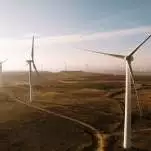
Renewable Energy: Wind Power, China
In China, coal-fired power dominates the grid and is typically responsible for over 80% of China’s electricity consumption. This leads to a very high amount of greenhouse gas emitted for each unit of electricity – about 0.88kg CO2 per kWh.
This Inner Mongolian wind farm is harnessing the power of the wind to generate clean electricity for the north China power grid. The wind farm has a total capacity of 49.5 MW and is made up of 30 wind turbines. By replacing grid-connected fossil fuel-fired power plants with clean energy, this project is reducing fossil fuel consumption and avoids the resulting emissions, such as carbon and sulphur dioxide.
The project has also generated job opportunities for local people, and contributes to developments in the economy and infrastructure within the local region.
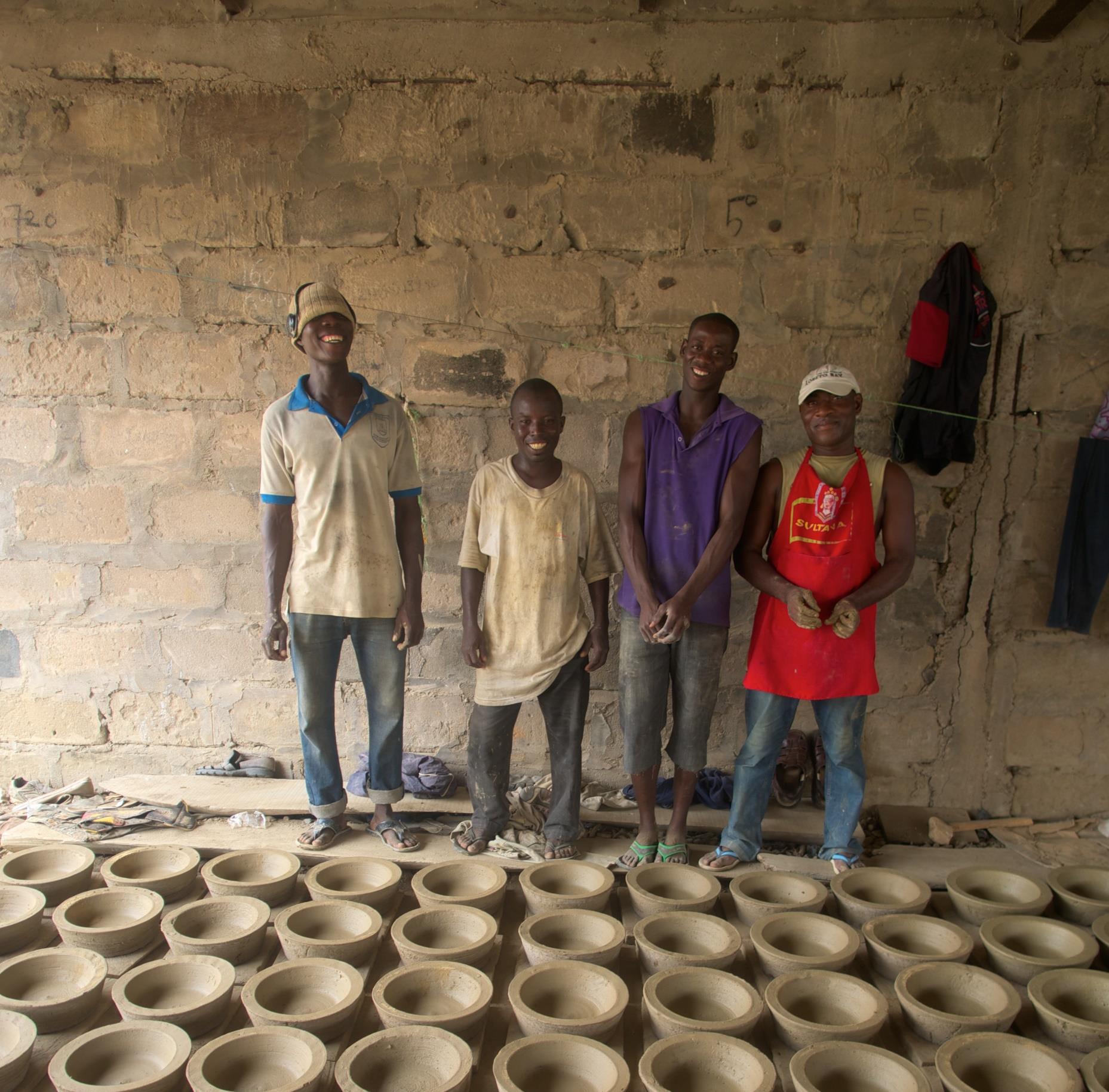
Gyapa Efficient Stoves Project, Ghana
Nearly 3 billion people in the developing world cook food and heat their homes with traditional cookstoves or open fires. The World Bank estimates that 4 million premature deaths occur every year as a result. In Ghana more than 80% of the population use solid fuels for cooking.
This project introduces the Gyapa to families in Ghana. An efficient cookstove, the Gyapa cooks food more quickly, requires 50% less fuel and is less smoky, meaning it not only cuts carbon emissions, but reduces exposure to toxic fumes.
A key outcome from this project is job creation. The stoves are made locally; the liners by a small group of accredited local ceramicists who have received specialist training and the metal claddings by a further group of accredited manufacturers. The project provides training and quality control services and distributes the stoves through a wide network of retailers.
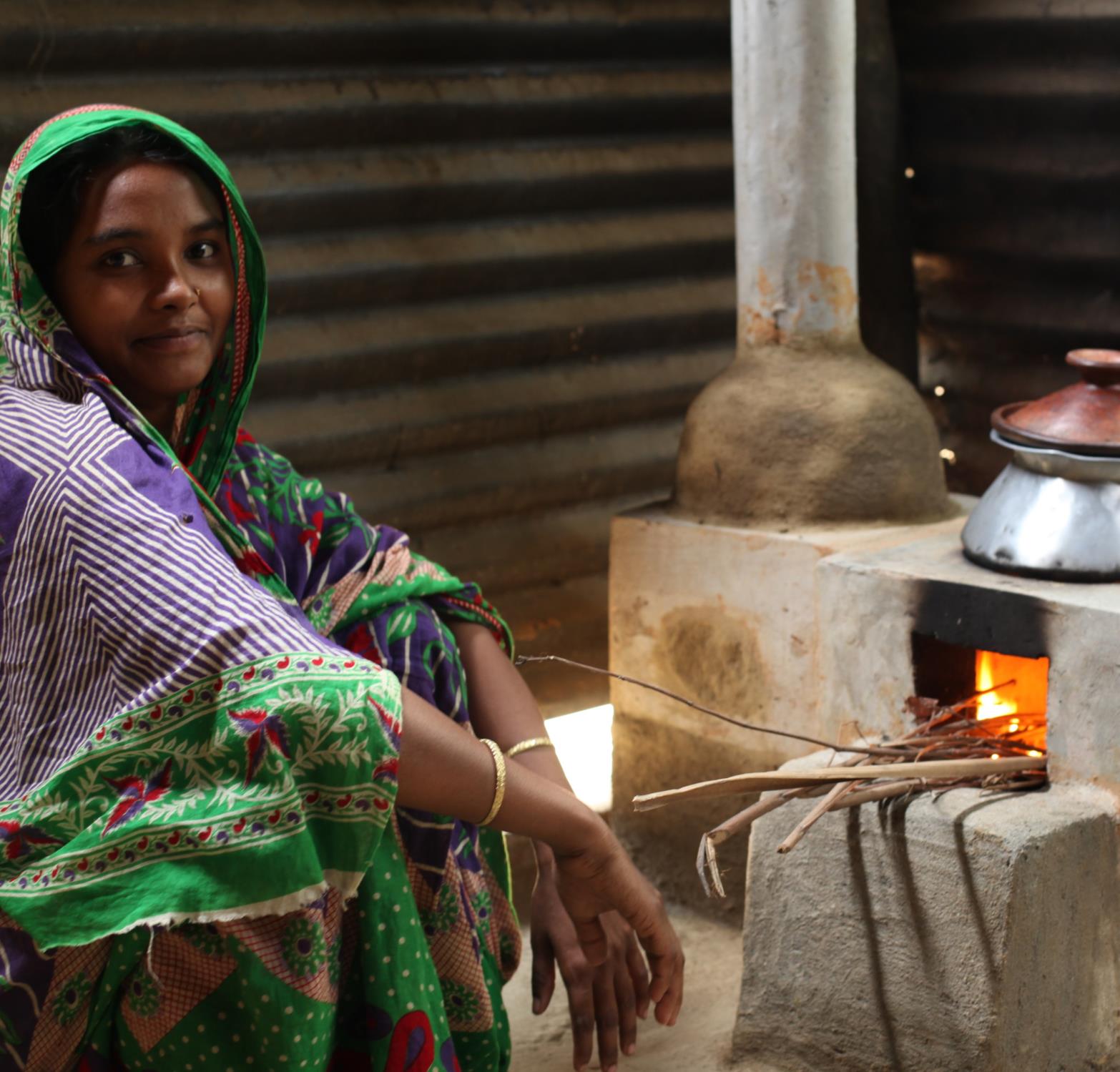
Safer and Cleaner Cookstoves, Bangladesh
Less than 20% of the 35 million Bangladeshi households have access to clean cooking. Traditionally, cooking is done over an open firepit, releasing smoke and particulate pollutants, contributing to 46,000 premature deaths a year and causing millions in the country to suffer from respiratory and cardiovascular diseases and eye and skin infections. Women and children are particularly affected, due to their role in food preparation.
This project is changing this through its Bondhu Chula, which loosely translates as the ‘friendly stove’. The combustion chamber is designed to ensure a more efficient burn reducing fuel use and the chimney takes the harmful pollutants out of the house. The project works with micro-entrepreneurs who receive training in stove production, sales and marketing and after-sales service.
Our Carbon Strategy Has Four Elements:
- REDUCING
Emissions using our multi-award winning proprietary platform, Site Manager, which helps users to minimise idling, excessive fuel use and emissions. Our experience is that customers reduce idling from an average of around 18% to less than 5% using this approach. As well as reducing emissions customers also reduce their fuel costs. - OFFSETTING
The balance using Ardent’s award winning not-for- profit carbon offsetting service in conjunction with leading carbon developer and B-Corp, Climate Care. The process is open and transparent with full details and costs published on Ardent’s website. For the past 2 years Ardent has also purchased carbon credits to offset the emissions from its entire HGV fleet meaning that all customer deliveries and collections are completely carbon neutral. - INVESTING
In the latest fleet which has the most recent, up to date technologies that are at the leading edge of emissions standards and are fuel efficient at the same time. In the last 4 years Ardent has spent over £250m on new fleet resulting in the company having one of the most modern and up to date fleets in the UK today. - INNOVATING
By trialling new technologies including electric machines and alternative fuels such as HVO. Ardent has invested in 6m electric telehandlers, however, our view is that the prohibitively high capital and rental costs of this equipment are likely to be a disincentive to many customers. Hydrogen is likely to be a more practical solution although the technology is still in its infancy. Ardent is also trialling alternative fuels such as HVO, however, customers should be aware that while these reduce particulate tail-pipe emissions they do not offer tail-pipe greenhouse gas reductions which are instead delivered in the overall well-to-wheel supply chain. Well-to-wheel means that all direct and indirect emissions resulting from a fuel’s supply chain are considered, rather than simply measuring tail-pipe output.
Ardent sits on the sustainability committee for the European Rental Association (ERA) and is a Gold member at the Supply Chain Sustainability School.
Our close work with both organisations helps shape policy and produces actions and not excuses. This philosophy is embedded in everything we do to lead the industry towards a sustainable carbon neutral future.
